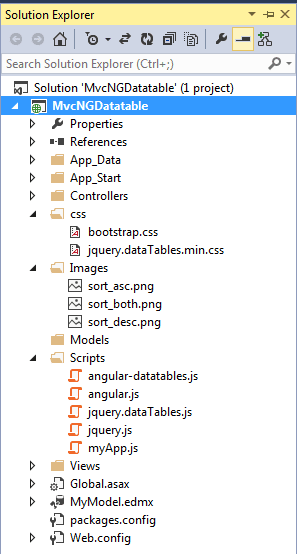Introduction
Almost all the web application need to show tabular data with server-side filtering, sorting, and paging features for resolve performance issue when working with a large amount of data. Many AngularJS grid tools are available nowadays but very few decent samples can be found.
Here in this example, I have implemented very basic datatable in angularjs application with the help of angular-datatables for made the article very simple and clean for beginners. In the next article, we will see datatables server-side paging, sorting and filtering in angularjs application.
Just follow the following steps in order implement Datatables in AngularJS and asp.net MVC.
Here In this article, I have used Visual Studio 2013Step-1: Create New Project.
Go to File > New > Project > ASP.NET Web Application (under web) > Entry Application Name > Click OK > Select Empty template > Checked MVC (under "Add folders and core references for" option) > OKStep-2: Add a Database.
Go to Solution Explorer > Right Click on App_Data folder > Add > New item > Select SQL Server Database Under Data > Enter Database name > Add.Step-3: Create a table.
In this example, I have used 1 table as belowStep-4: Add Entity Data Model.
Go to Solution Explorer > Right Click on Project name form Solution Explorer > Add > New item > Select ADO.net Entity Data Model under data > Enter model name > Add.A popup window will come (Entity Data Model Wizard) > Select Generate from database > Next >
Chose your data connection > select your database > next > Select tables > enter Model Namespace > Finish.
Step-5: Add required js (dependencies of angular-datatables) files in the application.
Here I have created a folder named "Scripts" first, and then I have added dependencies js files of angular-datatables.Right Click on your solution file (from solution explorer) > Add > New Folder > Renamed your folder (here I have renamed as "Scripts"). and then
Right click on your folder (just created) > Add > Existing Item > select dependencies js files file > Add. (Download)
Step-6: Add required css files in the application.
Here I have created a folder named "css" first, and then I have added 2 css files.Right Click on your solution file (from solution explorer) > Add > New Folder > Renamed your folder (here I have renamed as "css"). and then
Right click on your folder (just created) > Add > Existing Item > select css files file > Add. (Download)
Step-7: Add 3 image files for sorting icons.
Same way I have added a folder named "images" here and then I have added 3 image files for sorting icon.Right Click on your solution file (from solution explorer) > Add > New Folder > Renamed your folder (here I have renamed as "Images"). and then
Right click on your folder (just created) > Add > Existing Item > select image files file > Add. (Download)
Step-8: Create a javascript file for angular components.
Here I have added a javascript file in the "Scripts" folder for add angular components (module, controller etc).Right click on your "Scripts" folder > Add > New Item > select "javascript" file > Enter name (here "myApp.js")> Ok.
Write following code
var app = angular.module('MyApp', ['datatables']);
app.controller('homeCtrl', ['$scope', '$http', 'DTOptionsBuilder', 'DTColumnBuilder',
function ($scope, $http, DTOptionsBuilder, DTColumnBuilder) {
$scope.dtColumns = [
DTColumnBuilder.newColumn("CustomerID", "Customer ID"),
DTColumnBuilder.newColumn("CompanyName", "Company Name"),
DTColumnBuilder.newColumn("ContactName", "Contact Name"),
DTColumnBuilder.newColumn("Phone", "Phone"),
DTColumnBuilder.newColumn("City", "City")
]
$scope.dtOptions = DTOptionsBuilder.newOptions().withOption('ajax', {
url: "/home/getdata",
type: "POST"
})
.withPaginationType('full_numbers')
.withDisplayLength(10);
}])
Step-9: Create a Controller.
Go to Solution Explorer > Right Click on Controllers folder form Solution Explorer > Add > Controller > Enter Controller name > Select Templete "empty MVC Controller"> Add.Here I have created a controller named "HomeController"
Step-10: Add new action into your controller for getting the view, where we will show data in datatables.
Here I have added "Index" Action into "Home" Controller. Please write this following codepublic ActionResult Index()
{
return View();
}
Step-11: Add view for your Action & design for showing data in datatables.
Right Click on Action Method (here right click on Index action) > Add View... > Enter View Name > Select View Engine (Razor) > Add.HTML Code
@{
ViewBag.Title = "Index";
}
<h2>Index</h2>
@* CSS *@
<link href="~/css/bootstrap.css" rel="stylesheet" />
<link href="~/css/jquery.dataTables.min.css" rel="stylesheet" />
@* JS for angularJS and Datatable *@
<script src="~/Scripts/jquery.js"></script>
<script src="~/Scripts/jquery.dataTables.js"></script>
<script src="~/Scripts/angular.js"></script>
<script src="~/Scripts/angular-datatables.js"></script>
@* JS for our angularjs module, controller etc. *@
<script src="~/Scripts/myApp.js"></script>
@* HTML *@
<div ng-app="MyApp" class="container">
<div ng-controller="homeCtrl">
<table id="entry-grid" datatable="" dt-options="dtOptions" dt-columns="dtColumns" class="table table-hover"></table>
</div>
</div>
Step-12: Add an another action into your controller for getting data from a database for showing in datatables.
public ActionResult getData()
{
using (MyDatabaseEntities dc = new MyDatabaseEntities())
{
return Json(dc.Customers.ToList());
}
}




